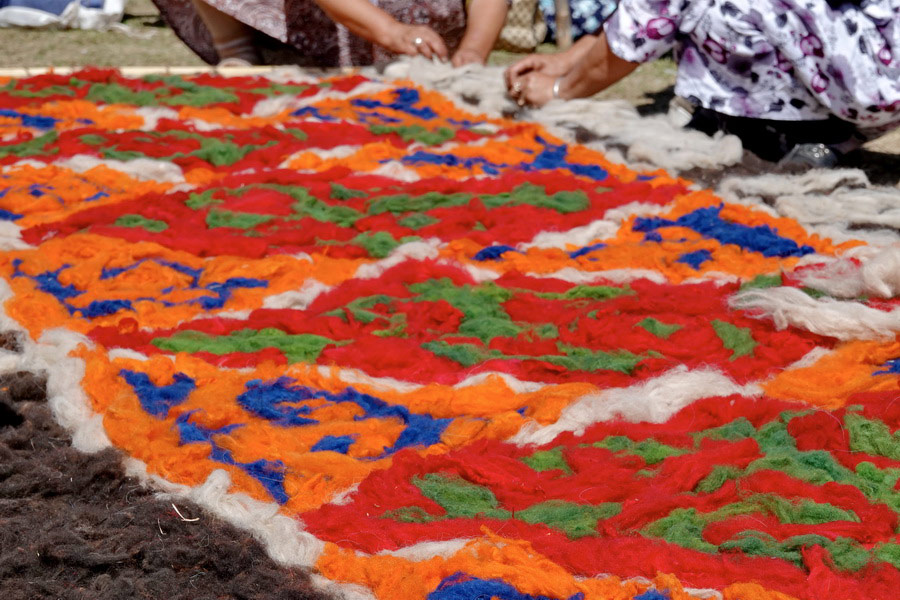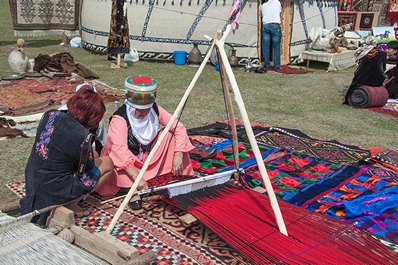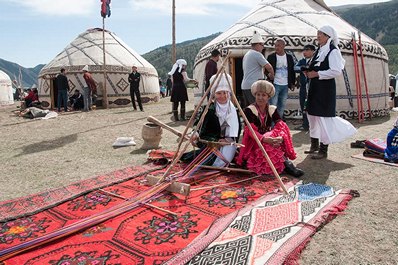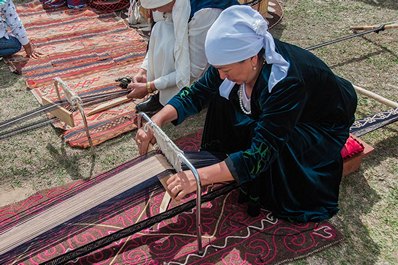
Kyrgyz textiles feature mostly designs from nature, and materials that were easily found in the mountains and their surroundings. Felt and wool are common materials, as are reeds and embroidery thread. Most of the motifs and designs reflect the mountains, rivers, plants, and animals that live in Kyrgyzstan, forming an important part of the traditional culture of Kyrgyzstan.
Shyrdaks are the most iconic Kyrgyz textile, easily recognizable from their bold patterns. Made with two pieces of felt sewn together and then cut, shyrdaks feature symmetrical designs and two main colors. Machine-made versions can be cheaper, since handmade versions take weeks to produce. Depending on how much wear a shyrdak gets (whether it’s placed on the wall or on the floor), shyrdaks can last for years or decades. The designs feature sheep, goats, dogs, or flowers, in sometimes abstract patterns.
Tush kyiz are intricate embroideries, often made for marriages. The designs feature plants and flowers, and sometimes animals, embroidered onto a soft cloth, and are hung on the walls of yurts. Sometimes the designs also featured the name of the married couple or the year the tush kyiz was made. Nowadays, these large embroideries are being cut up and incorporated into other works, such as pillowcases, bags, and table settings. The intricate stitching and beautiful designs make tush kyiz one of the most spectacular textiles in Central Asia.
Kurak are items sewn together from fabric scraps. The name kurak comes from the word “kura”, which means sewn together, or put together from separate pieces. Kurak may be hats, children’s clothing, blankets for cradles, wedding curtains, mattresses, pillows, covers for saddles, bags, or carpets. Scraps are considered to have magical properties, and were used for a variety of important items. Kyrk koynok is a shirt made of scraps from 40 different neighbors, and is sewn for the baby’s 40th day. Black and white scraps are the most valuable, and are used to make geometric patterns such as the camel’s eye, the crane, the amulet, and the star.
Ala kyiz are also made of felt, and may feature similar designs as shyrdaks, but are made through a different process. Rather than cutting large sheets of felt, ala kyiz are made by layering wisps of felt to create a whole carpet. Then the whole carpet is soaked in warm water and rolled to bind the layers together. The result is designs without strictly defined borders that seem to melt into each other to create a whole image. Though less sturdy and less durable when compared to shyrdaks, the tend to be designs more intricate and colorful.
Chiy are reeds that grow on the steppes, and are harvested and dried to make mats. These mats can be plain, or can feature designs. Chiy are often used in yurts as extra insulation, or under carpets to protect against dampness. These mats are also a crucial part in the felting process when making shyrdaks and ala kyiz.




